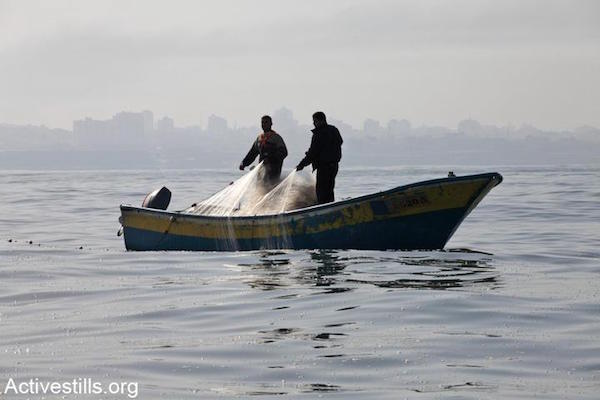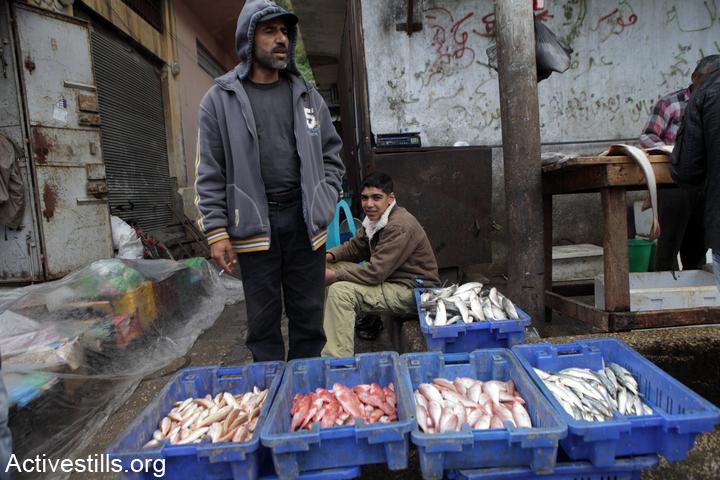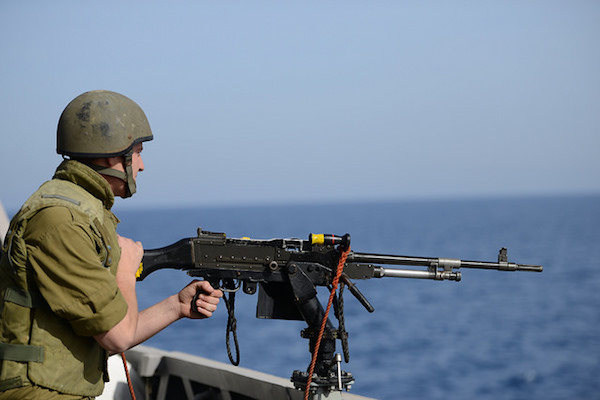One Palestinian fisherman is reportedly wounded by Israeli navy fire, four are arrested and their boats seized. The size of the zone where Israel allows Gazans to fish changes at the whims of Israeli military commanders and politicians, who have in the past openly discussed how they use it as collective punishment.
By Haggai Matar and Michael Schaeffer Omer-Man

The Israeli navy opened fire on unarmed Palestinian fishermen off the coast of the northern Gaza Strip Saturday morning. No injuries were reported.
On Friday Israeli naval forces arrested four Palestinian fishermen off the southern Gaza coast. Israel released three of the four men Saturday morning. The fourth, who was reportedly wounded by naval gunfire, was expected to be released later in the day.
According to witnesses cited by both the Ma’an and Wafa news agencies, both incidents took place within the designated fishing zone.
Earlier this week the Israeli army expanded the area in which it permits Palestinians to fish from six to nine nautical miles off the coast. Palestinians are still not allowed to venture more than six nautical miles off the coast in the northern half of the Strip.
The limitations affect the amount and types of fish that can be caught, and results in overfishing within the permitted areas.

According to the Oslo Accords which created the systems that defined the mechanisms according to which the Israeli military rules Palestinians in the West Bank and Gaza, Israel agreed to allow fishermen in Gaza to operate freely in a zone extending 20 nautical miles off the coast.
The Israeli army has not abided by that commitment for the past decade. Israeli authorities first shrunk the zone to 10 nautical miles, then three nautical miles. As part of a cease-fire agreement with Hamas after the 2014 Gaza war, however, Israel agreed to expand the zone to six nautical miles.
The size of the permitted fishing zone changes at the whim of Israeli military commanders and politicians, who have in the past openly discussed how they use it as collective punishment against civilians in response to rocket fire from armed groups. Sometimes Israeli naval forces simply announce via loudspeakers that they are reducing the size of the zone on a given day.
Palestinian fishermen regularly report that Israeli naval forces harass them, shoot at them, and seize their boats well within the authorized zone. Even when the army admits shooting Palestinian fishermen inside the zone, nobody is held accountable.

There were at least 139 incidents in which Israeli military forces fired on Palestinian fishermen in 2015, wounding at least 24 fishermen and damaging at least 16 fishing boats, according to the Palestinian Center for Human Rights (PCHR). An additional six incidents involved artillery shells. The IDF arrested at least 71 fishermen and seized 22 boats in the same period.
Israel’s decade-old siege on the Gaza Strip, reinforced by Egypt, is enforced through a military blockade on Gaza’s land and sea borders, full control of the Strip’s airspace and the destruction of its only airport. Despite the fact that Israel pulled its troops out of Gaza in 2005 the army still controls the Strip’s currency (the new Israeli shekel), the population registry, large parts of the electricity and water grids, all imports and exports, and decides who may enter and exit through the only regularly open passenger border crossing.
Furthermore, the Israeli army still controls movement inside the Gaza Strip. Israeli troops maintain a no-go zone several hundred meters from the border fence. Palestinian farmers and protesters who enter the no-go zone, which comprises a significant portion of Gaza’s arable land, are regularly fired upon and sometimes killed.
Earlier this year +972 revealed that the army had begun spraying herbicides and germination inhibitors inside the Gaza Strip, damaging some 420 acres of Palestinian-owned crops. The army also regularly enters the Gaza Strip in order to clear brush and other obstacles to its line of sight which it claims Palestinian militants can use to launch attacks against Israeli troops.
The Israeli army also restricts the cellular internet speeds residents of the Gaza Strip may enjoy. The army decides with whom Gaza businesses may conduct trade, including whether they can trade with other Palestinians in the West Bank, what goods they may trade, and every other aspect of imports and exports.
A shorter version of this article first appeared in Hebrew on Local Call. Read it here.


